Marketing functions in every industry are booming. With an abundance of options, customers are eager to see what businesses can offer before choosing the right fit for their needs.
This ultimately drives companies worldwide to present their best foot forward, not just in the products and services they launch but through their marketing campaigns, festive sales, and existing product range. One of the most effective ways of delivering this is through ad copy.
This abundance of options also indicates the competitive nature of the market. Ad copy presents a business with the most compelling information to drive revenue. When businesses write good ad copy, they can steer the viewer’s focus – which is a huge advantage in itself – drive lead generation and boost brand imaging.
The internet and its technological developments now allow over 5.44 billion people to access content from virtually anywhere. This highlights the importance of creating compelling ad copy in the digital space.
Additionally, customer needs are continuously evolving; businesses must be considerate and innovative in their approaches to effectively write good ad copy.
This article will explore key steps, tips, and effective strategies for creating ad copy and jumpstarting your marketing quality with recent examples for inspiration. Read on!
What Is Ad Copy?
Ad copy is the text used in advertisements to engage, inform, and persuade potential customers to take action. Ad copy is marketing text that fuels sales and brand awareness.
- Whether through a social media post, a Google ad, or a captivating billboard, your brand is given voice to whisper or shout your message directly to potential customers through ad copy. In the noisy advertising world, your ad copy is your secret weapon.
- Ad copy’s intent is to go beyond an informative stance to persuade, motivate, and compel action. Effective ad copy stops viewers from scrolling by or shedding a casual glance at a product and piques their interest for a click-through and completed purchase.
- Good ad copy is about communicating value in the simplest, most persuasive way possible. It is a tool for guiding potential customers through a decision-making process, using language that connects with them on an emotional or practical level. When done well, ad copy can drive conversions, build brand loyalty, and ultimately increase revenue for businesses.
As per folks Pearl Lemon has researched, 40% of marketers now use AI to generate ad content, the challenge has shifted to making that content feel more authentic. That’s why many brands choose to humanize their AI-generated copy ensuring it sounds natural, relatable, and aligned with how real people communicate.

Prerequisites Before Writing Ad Copy
Before diving into the creative process of writing ad copy, there are essential preparatory steps that should be taken. These steps help ensure that your ad copy is targeted, effective, and aligned with both the product you’re promoting and the audience you’re trying to reach. Two critical prerequisites are knowing your product thoroughly and studying your competition.
1. Know Your Product
Understanding your product inside and out is the foundation of writing strong ad copy. If you don’t have a deep knowledge of what you’re selling, it will be difficult to communicate its value to potential customers.
Start with the basics by listing your product’s features. What does it do? How does it work? But don’t stop there. Go beyond the features and dive into the benefits – how does this product improve the customer’s life or solve a problem? Knowing this helps you highlight the aspects of the product that matter most to your audience.
Ask yourself:
- What problem does my product solve? Every product or service is designed to meet a specific need. Your ad copy should reflect how it addresses that need.
- What makes it unique? This is your unique selling proposition (USP). It’s what sets your product apart from competitors and makes it stand out. Is it more affordable? Does it have a feature that no other product offers? Understanding this will allow you to showcase your product’s strongest points.
- What are the pain points of the audience? Identify the frustrations, challenges, or unmet needs your product resolves. When you know this, you can tailor your copy to show how your product directly alleviates these problems.
Utilize customer feedback and reviews to gain knowledge of what people like about your product. Many marketers brainstorm ideas verbally during meetings or quick recordings. Tools that let you convert audio to mind map can capture those discussions visually, making it easier to refine and structure your next ad campaign. And what problems they are facing which can be addressed.
By knowing your product in-depth, you can create ad copy that is focused, compelling, and convincing. Your expertise will shine through in the copy, establishing trust with potential customers and making your message more persuasive.
2. Study Your Competition
To write ad copy that stands out, you need to have a clear understanding of your competition. Competitive analysis allows you to see what others in your industry are doing well, and more importantly, where there might be gaps you can fill. Start by identifying your top competitors. Look at the ads they’re running, whether on social media, Google Ads, or other channels. Take note of the following:
- What messaging are they using? Are they focusing on certain features or benefits that are resonating with customers?
- What tone do they use? Are their ads formal, casual, humorous, or serious? Knowing their tone can help you decide whether to align with industry standards or differentiate your brand by using a different approach.
- How are they positioning their products? Are they promoting low-cost, high-quality, or convenience? Understanding this allows you to see how your product can be positioned in a unique way.
- Pay attention to their calls to action (CTAs). What language do they use to prompt action? Are they offering discounts, limited-time offers, or exclusive access?
- It’s also useful to observe customer feedback on your competitor’s products. Read reviews or comments on their social media platforms. This can help you identify common customer complaints or pain points, which you can address in your own ad copy.
By studying your competition, you gain insights into industry trends, customer expectations, and opportunities for differentiation. This knowledge allows you to write ad copy that not only meets market standards but exceeds them, giving you a competitive edge.
Key Steps to Write Good Ad Copy
With an understanding of what good ad copy can do for you, effectively executing “the how” of the process is possible. Writing ad copy that captures attention and drives conversions is both an art and a science.
To ensure your ad copy resonates with your audience and achieves its goal, it’s important to follow a structured process. Here are five straightforward steps to writing good ad copy:
Step 1: Understand Your Audience and Goals
Your direction and destination must be clear before creating a copy. The first step to writing good ad copy is to conduct relevant research to understand your audience and jot down your goals.
- The first step in any successful ad copy is identifying who you are writing for. You need to have a clear picture of your target audience, including their age, gender, interests, and behavior.
- Understanding your audience means going beyond just demographics. You need to know their pain points and desires. What challenges are they facing, and how does your product or service offer a solution? People don’t buy products; they buy solutions to their problems.
- Understanding your audience is a marketing pillar. It is best done through analytical tools to understand demographics and customer surveys or questionnaires to gain detailed insight into their interests and pain points.
Once you’ve identified your audience, you must define your goals. Review your goals including addressing your primary intent from the copy. Marketing generally focuses on three main goals: revenue, brand awareness, and positive website traffic. This step also involves infusing your business values and tone into your ad copy.
For example, if your goal is to drive sales, you might use more persuasive language, focusing on benefits and urgency. If you’re looking to increase awareness, your copy might be more educational and informative.
Finally, make sure to speak your audience’s language. Matching the language and style of your audience increases relatability and trust.
Step 2: Create Your Headlines
The next step is to nail your headline.
Headlines are the gates to your ad copy and the first appeal for your viewers to enter your content. The headline is arguably the most important part of your ad copy. It’s the first thing people see, and it determines whether they will continue reading or scroll past. Your headline must incite curiosity, excitement, and interest in reading the body copy.
To create an effective headline, you need to be clear and concise with your message. A good headline communicates the core message in just a few words. You want to capture the essence of your ad without overwhelming the reader with too much information upfront.
A great example of this is Walmarts Google search engine ads for hiring new employees. They are direct with their message that they are hiring. And encourages by using the phrase “Apply Now”.

While it’s tempting to use attention-grabbing tactics, avoid clickbait headlines. Misleading your audience with sensationalized or exaggerated headlines may get clicks initially, but it can harm your brand’s reputation and lead to high bounce rates. Instead, be honest and straightforward. Your headline should give a clear sense of what the reader can expect from the rest of the ad.
Using power words is a great way to make your headlines more compelling. Words like “exclusive,” “free,” “limited,” or “guaranteed” evoke strong emotional responses and encourage people to take action.
Incorporating numbers and data into your headlines can also be highly effective. Headlines that include specific figures, such as “Boost Sales by 30%” or “5 Proven Strategies to Save Time,” tend to perform better because they promise concrete, actionable insights. Numbers provide clarity and make the headline feel more credible and authoritative.
Step 3: Craft Your Body Copy
Once you’ve nailed your headline, comes the body copy.
Thanks to the headline, viewers are already interested when their eyes land here. It’s time to deliver on that promise in the body of your ad. Your body copy should be simple and focused. Avoid the temptation to include too much information. Stick to the most important points that will help move your audience toward taking action.
With that in mind, your body copy must focus on benefits, not features. Delivering content that explains what you offer will explain why the customer should care. The key to effective body copy is focusing on the benefit or solution, rather than just listing features. While features describe what a product or service does, benefits explain how those features make the customer’s life better.
An excellent example would be Converse’s Ad for its Creator Edition shoe, which blended a catchy headline as a hook, stunning visuals, and a body ad copy that highlighted its key personalization feature.

With the pain points and interests you have uncovered in your research, addressing the problem your product/service solves is fundamental to writing good ad copy. It’s also important to address any questions or doubts your audience may have. Anticipate potential objections or concerns and proactively answer them in your copy.
Step 4: Finish With Your Calls to Action
The final part of an ad is the call to action (CTA). While this is the fourth step, it is also the heart of your ad copy.
The CTA must guide your potential customer to the next step, which entirely depends on your objective. Popular CTAs invite the viewer to purchase, subscribe, or share. A strong CTA is crucial because it provides clear instructions on the desired outcome. To make your CTA effective, you need to create urgency or scarcity. Phrases like “Limited Time Offer,” “Only Available Today,” or “Hurry – Stock Running Out” encourage the reader to act immediately, rather than delaying the decision.
Headspace, a mental wellness platform, executes this quite well with its “Install Now” button that also highlights its free trial plan to its viewers with “Start your free trial today” included in its CTA.
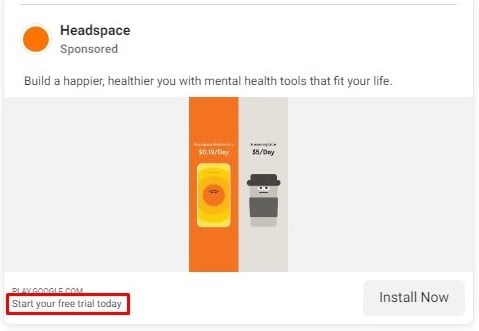
Your CTA must be direct and benefit-focused, with action as the required result. It should also direct the curiosity that has carried the customer this far in acting on your product. Your CTA should avoid vague language. Be specific about what you want the audience to do. Instead of saying “Learn More,” use stronger commands like “Get Your Free Trial,” “Buy Now,” or “Claim Your Discount.” The more direct and clear your CTA, the more likely your audience will follow through with the action.
In addition to strong wording, make sure you position the CTA strategically in your ad. It should stand out visually and be placed where the reader is most likely to click. Ensure that it’s easy to find and understand.
A well-crafted CTA can significantly improve your conversion rates by guiding your audience toward the next step.
Step 5: Test and Optimize
Your ad copy will give you results, and you must monitor them. This final step in ad copy is to test different variations.
No ad copy is perfect on the first try, which is why continuous testing and optimization are key to improving performance. One of the best ways to test your ad copy is through A/B testing. This involves creating two versions of your ad with slight variations, such as different headlines or CTAs, and seeing which one performs better. Testing allows you to make data-driven decisions and refine your copy based on real results.
To speed up this process, you can also use tools like AI Paraphraser to generate multiple creative versions of your ad copy quickly. It helps you test different tones, word choices, and sentence structures, allowing you to identify which variation connects best with your audience
It’s also important to try different formats. Depending on the platform you’re using, different ad formats may resonate better with your audience. Experiment with various formats to find what works best for your audience.
Tracking key metrics is essential for understanding how your ad is performing. By monitoring key metrics such as click-through rates (CTRs) and conversion rates, you can adapt and improve your ad copy strategy to what gives you the most results. Regularly reviewing these metrics helps you adjust your copy and strategy to maximize effectiveness.
Finally, make sure to optimize for mobile. A significant portion of your audience will likely be viewing your ads on mobile devices, so your copy needs to be concise and easy to read on smaller screens. Ensure that your CTAs are easy to click and that the overall design is mobile-friendly.
With these steps in mind, let’s equip you with what is essential in every ad copy.
10 Essential Tips and Tricks for Writing Ad Copy
1. Use Amazing Visuals
While the text in ad copy is crucial, amazing visuals can greatly enhance the impact of your message. Eye-catching images or videos help capture attention quickly and communicate your message more effectively. Visuals complement your copy by showing your product in action, highlighting key features, or evoking emotions. Strong visuals can also break up text and make your ad more engaging. Whether it’s a vibrant product image, an infographic, or a video, using high-quality visuals ensures your ad stands out and resonates with your audience more powerfully.
Use Predis.ai to create images, carousels, and video ads simply with the text input. Predis uses AI to generate ad creatives, social media posts, and product posts with ease for your marketing campaigns.
2. Appeal to FOMO (Fear of Missing Out)
Leveraging the Fear of Missing Out (FOMO) can drive quick decision-making. People often act when they fear losing out on an opportunity. Phrases like “Limited Time Offer” or “Only a Few Left” encourage urgency, prompting readers to act fast before the chance disappears. Creating scarcity or time-sensitive offers can effectively push potential customers toward making a purchase or taking the next step.
3. Incorporate Humor
When used correctly, humor can make your ad copy more relatable and memorable. A lighthearted tone can capture attention and create a positive emotional connection with your audience. Be mindful of the context and your target audience’s preferences. A clever or funny line can break the ice, make your brand more likable, and stand out among more serious, formal ads. Just ensure the humor doesn’t distract from the core message.
4. Avoid Overpromising
Overpromising may bring short-term gains but can damage your brand’s reputation in the long run. Making exaggerated claims about what your product can do leads to customer disappointment and distrust. Instead, be honest about your product’s strengths and limitations. Delivering on realistic promises builds credibility and loyalty, fostering long-term customer relationships. Always ensure that your ad copy aligns with what your product can truly deliver.
5. Include Emotional Triggers
Appealing to emotions in your ad copy can create a deeper connection with your audience. Whether it’s excitement, security, or happiness, emotional triggers make your message more compelling. For instance, a phrase like “Feel confident and in control” taps into the reader’s desire for empowerment. Emotional copy makes the product feel more personal and relevant, motivating the audience to take action based on how they want to feel.
6. Incorporate Storytelling
Storytelling humanizes your brand and makes your ad copy more engaging. A brief story about how your product solved a problem for a customer can create relatability and build trust. People remember stories better than mere facts, so incorporating storytelling into your ad copy helps you create an emotional connection. It allows your audience to visualize how the product or service can fit into their own lives.
7. Use Power Words in Headline
Power words are persuasive terms that trigger an emotional response. Words like “exclusive,” “limited,” or “proven” can make your headline more compelling and action-oriented. These words create a sense of urgency or excitement, encouraging the reader to continue engaging with your content. Power words help grab attention and elevate the perceived value of your offer, making your ad stand out in a crowded space.
8. Make Ad Body Readable
A readable ad is more likely to keep your audience engaged. Use short sentences, simple language, and plenty of white space to make your ad body easy to scan. If you want to further polish your writing and improve readability, tools like SEOMagnifier sentence rewriter can help rephrase and simplify text without losing its meaning. Bullet points and subheadings also help break up the text and highlight key points. Remember, most people won’t read every word, so ensure your copy communicates the main benefits quickly and effectively, even when skimmed.
9. Use Distinct CTA with Contrasting Colors
Your call to action (CTA) is crucial for driving conversions, so make sure it stands out. Use contrasting colors and bold fonts to ensure your CTA button or link is easily noticeable. Phrases like “Buy Now” or “Get Started” should be direct and action-oriented. A visually distinct CTA with clear, concise language makes it easier for your audience to understand what you want them to do next.
10. Take an Experimental Approach
Effective ad copywriting requires ongoing testing and refinement. Use A/B testing to compare different versions of your ad copy and see what resonates best with your audience. Experiment with headlines, CTAs, and formats to optimize performance. By taking an experimental approach, you gather valuable data on what works, allowing you to improve and fine-tune your ad copy over time for maximum effectiveness.
Elevate your ad campaigns with Predis.ai's AI Ad Generator - design compelling ads effortlessly.
Three Effective Strategies for Ad Copy Creation
With the tips and process set, there are a few approaches that, when adopted, can transform your ad copy’s net impact. While it may seem like going the extra mile, the current customer expectations from content that reaches them are such.
Here are three strategies that are becoming fundamental to delivering a competitive edge in your ad copy,
1. Leverage Psychology in Your Ad Copy
Customer needs and user behavior are crucial parts of the process. Leveraging your customers’ psychology in your content is a sure guarantee of good ad copy. In fact, it increases your copy’s relatability to fuel higher CTRs and lead generation chances.
Here are psychological aspects that, when incorporated, enable you to write good ad copy.
- Reciprocity: People feel obligated to return favors. Highlighting valuable content or free trials in your ad copy builds trust and encourages users to take the desired action.
- Authority: When businesses are seen as industry experts or thought leaders, customers grow comfortable with what the brand offers. Write good ad copy that features testimonials from experts or happy customers, showcases awards and accomplishments, and highlights collaborations with reputable organizations or influencers.
- Social Proof: Viewers trust recommendations from fellow people and organizations quickly. Your ad copy can showcase the number of satisfied customers you have, display user reviews and ratings, or mention social media trends associated with your product/service. Social proof is quite effective on every platform, especially Instagram and Facebook, because of their vast audience reach.
- Scarcity and Urgency: Limited-time offers and limited availability can create a sense of urgency and encourage people to act quickly. Highlight limited-time discounts, mention low stock levels (if applicable), or use phrases like “Don’t miss out!”
- Loss Aversion: People are more likely to act to avoid losing something than to gain something. Your ad copy should emphasize the potential negative consequences of not using your product/service.
Using these psychology models in your ad copy can create a stronger emotional connection with your audience, leading to higher engagement and conversions.
2. Maximize Impact With Advanced Targeting
While demographic targeting can provide a foundation for writing good ad copy, taking targeting to an advanced level allows you to tailor more personalized messages.
With this, resonating with specific audience segments is much more seamless. Here are some methods to deliver advanced audience targeting,
Targeting Interests, Behaviors, and Time Zones:
With technological developments, many preferences have evolved beyond age and geographic data.
- While these basic demographics can provide great insight into language and tonality, focusing on interests and behaviors allows you to use relevant keywords and speak directly to your audience’s passion for their niche interests.
- Social media platforms like Facebook and Instagram allow advertisers to create highly customized audience segments based on user interests (e.g., fitness enthusiasts, tech lovers) and behaviors (e.g., online shoppers, frequent travelers). Additionally, targeting based on time zones ensures that your ad reaches your audience when they’re most active.
- Additionally, timing your copy for your demographic time zones is vital to the best content reception. For this, content calendars built into Predis.ai are exceptionally helpful in delivering occasion-specific ad copy to your audience.
Device Targeting
- Not all devices offer the same user experience, and people interact with ads differently depending on whether they’re using a mobile phone, tablet, or desktop. Device targeting allows you to tailor your ad copy to specific devices.
- People consume content differently on mobile devices than on desktops. In fact, 4.8 billion people use smartphones as of 2024. Optimizing separate content for mobile and desktop users is a smart way to write good ad copy.
- Concise messaging and clear CTAs best suit mobile users, whereas desktop-focused ad copy has more space for storytelling or detailed product information. By optimizing your copy for different devices, you ensure a seamless user experience and increase the chances of conversion.
Connection Targeting
- Focusing on recent interactions is another excellent approach to writing good ad copy. You can tailor your content for people who have liked your social media content or web page to showcase exclusive content or special offers. This fosters a sense of community and encourages deeper engagement.
- Connection targeting refers to targeting users based on how they are connected to your brand or social media pages. For example, you can create separate ads for people who have already liked your page or interacted with your brand versus those who are entirely new to your business.
- Users who are already familiar with your brand may respond better to loyalty offers or product updates, while new users may need educational content or a first-time discount to encourage them to engage. Tailoring your copy based on the audience’s relationship with your brand improves relevance and increases conversions.
3. Tailor Copy According to the Platform
This strategy is about specifically tailoring ad copy to different platforms and allowing you to maximize their unique strengths and resonate with their respective audiences.
To write good ad copy, you must deliver relevant content while considering each platform’s user activity and focus.
Google Search Ads:
- Users actively search for solutions, so focus on keywords matching their queries.
- Keep headlines short and informative, highlighting your core benefit or solution.
- Use a strong CTA that encourages immediate action, such as “Buy Now,” “Get a Quote,” or “Learn More.”
- Utilize site link extensions, call extensions, or location extensions to provide additional information and encourage clicks.
Facebook and Instagram Ads:
- Focus on delivering copy through eye-catching images or videos that stop users as they scroll through their feeds.
- Craft compelling narratives that connect with your audience on an emotional level.
- Lean towards informal language and address the user directly to create a personal connection. Of course, this should not conflict with your business tone.
- Showcase customer testimonials or reviews to build trust and credibility.
LinkedIn Ads:
- Use a formal and professional tone to appeal to the business-oriented audience.
- Incorporate industry-specific keywords to your target professionals.
- Clearly articulate the benefits your product or service offers to businesses and professionals.
- Share insightful content or industry news to position your brand as an authority.
Considering the depth of customer needs, focusing on identifying and reaching the right audience, and delivering carefully considered content, these key strategies are vital in every ad copy that you generate.
Turn text into engaging Display Ads with Predis.ai’s Google Display Ads Maker – boost your ad clicks and engagement! Leverage the power of AI to make Display ads that convert.
Best Recent Examples of Good Ad Copy
Effective ad copy combines compelling text, eye-catching visuals, and a clear call to action (CTA) to engage audiences and drive conversions. Below are six recent ad copy examples from prominent brands like Netflix, DoorDash, Amazon, Apple, Google, and Tiffany & Co. These examples highlight how simplicity, emotional resonance, and strong visual elements work together to create memorable ads.
1. Netflix: “One Story Away”

Why it works:
This ad copy from Netflix effectively taps into the audience’s desire for new, exciting content. The simple headline, “One Story Away,” sparks curiosity, making viewers feel that they’re always on the verge of discovering a great new show or movie. The use of video enhances emotional engagement, showcasing the wide variety of content available on Netflix. The CTA, “Subscribe,” is direct and aligns with Netflix’s goal of increasing subscriptions. This campaign succeeds in blending visual storytelling with a clear and concise message.
2. DoorDash: “Every Flavour Welcome”
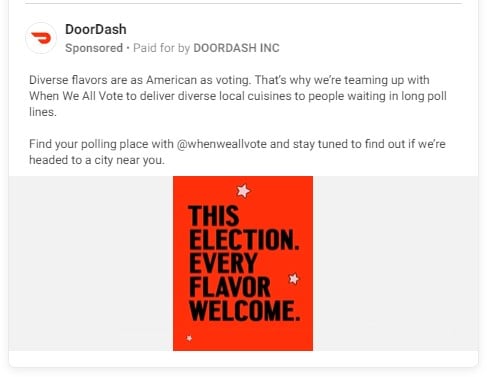
Why it works:
DoorDash’s ad copy cleverly ties the theme of diversity in food with civic engagement, making the brand feel socially responsible and community-driven. By linking food diversity to American voting, the ad fosters a sense of unity. The collaboration with “When We All Vote” adds credibility to the message, and the simple layout ensures that the focus remains on the powerful message. The CTA, “Learn More,” prompts users to engage further by finding polling locations, making the ad action-oriented while connecting on an emotional level.
3. Amazon Hub: “A Side Hustle for Your Main Hustle”

Why it works:
This Amazon Hub ad speaks directly to the growing trend of side gigs and freelance work. The headline, “A Side Hustle for Your Main Hustle,” is catchy and relatable, appealing to those looking to earn extra income. The visuals, which showcase a successful delivery, reinforce the message of opportunity and success. The CTA, “Learn More,” encourages viewers to take the next step in exploring how they can join Amazon Hub, making the ad practical and action-focused.
4. Apple Music: “Hear Something You Haven’t”
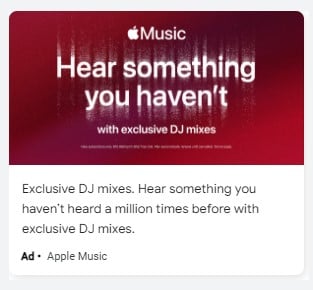
Why it works:
Apple Music’s ad copy focuses on exclusivity and discovery, encouraging users to experience something fresh and unique. The repetition of “exclusive” emphasizes the rarity and value of the content, making it feel special. The minimalistic design aligns with Apple’s branding, maintaining a clean and elegant appearance. With the entire ad being clickable, the user experience is streamlined, making it easy for users to explore Apple Music’s exclusive DJ mixes without distraction.
5. Google: “Discover More with the Google App”
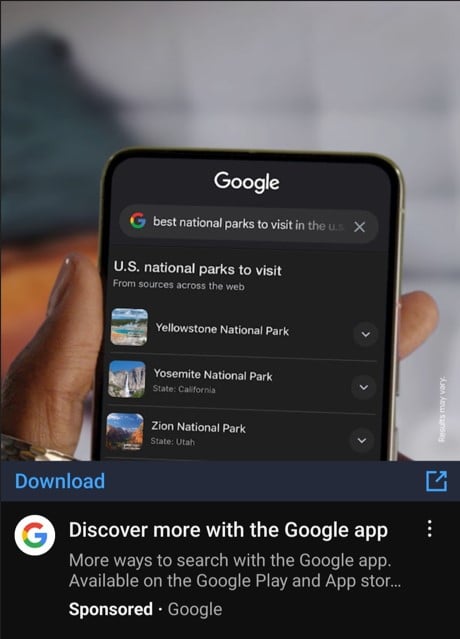
Why it works:
Google’s ad copy focuses on the app’s versatility and functionality, promoting it as the go-to tool for discovering information. The headline, “Discover More,” aligns with Google’s mission of making information accessible and easy to find. The visuals reinforce this by showing the search results on a mobile device, emphasizing convenience and efficiency. The CTA, “Download,” is placed prominently and encourages immediate action, making it easy for users to engage with the Google app.
6. Tiffany & Co.: “Tiffany Engagement Rings”
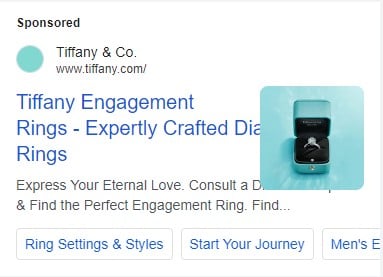
Why it works:
Tiffany & Co.’s ad copy appeals to emotions with the phrase “Express Your Eternal Love,” tapping into the sentiments associated with engagement rings. The emphasis on craftsmanship and expert consultation adds a layer of trust and quality, which is vital for high-end purchases like engagement rings. The clean visuals focus on the product’s luxury and beauty, while the CTA leads users directly to the Tiffany website, encouraging further exploration.
These recent ad copy examples from Netflix, DoorDash, Amazon, Apple Music, Google, and Tiffany & Co. demonstrate how brands can combine creative copy with visually appealing designs and clear CTAs to engage audiences effectively. Whether it’s fostering curiosity, driving action, or evoking emotions, each example offers valuable lessons in creating compelling ads that resonate with users.

Wrapping Up: How to Write Good Ad Copy?
Ad copy will remain a fundamental part of every business’s marketing strategy. The key steps, tips, and strategies we’ve covered will no doubt jumpstart your journey in creating compelling ad copy.
Although crucial, it is important to remember that marketing is one of many functions that drive business revenue and continuity.
The resources required to write good ad copy consistently are vast and often require a helping hand from experts to avoid exceeding organizational budgets. Predis.ai‘s AI-driven platform becomes the perfect fit to balance costs and deliver impactful ad copy.
FAQs
To write a good ad copy, focus on your audience’s needs. Use clear and concise language that highlights the benefits of your product or service. Ensure the copy is easy to read, emotionally engaging, and ends with a strong call to action (CTA). Tailor the message to the platform, and address any pain points your audience may have. Finally, keep testing and refining to improve results.
Here’s a simple ad copy example from a fitness app:
“Want to stay fit without leaving home? Try our 10-minute workout routines and start your fitness journey today! Download the app for free and get moving!”
This copy highlights the product’s benefit, provides a solution, and ends with a clear CTA.
Start by capturing attention with a strong headline. Follow up with a concise body copy that explains the main benefit of your product or service. Make sure to address your audience’s pain points and focus on solutions. Use engaging, action-oriented language and close with a clear CTA. For instance:
“Achieve glowing skin with our all-natural moisturizer. Order today and get 20% off your first purchase!”
Yes, A/B testing is essential. It allows you to compare different versions of your ad copy to see what resonates best with your audience. Test different headlines, CTAs, and messaging styles to continuously improve performance.
Related Content,
Best Models and Principles for Ad Copywriting with Examples
10 Best Ad Copywriting Examples from Top Brands
Ad copy vs. Ad creatives: What is better for your business?















